Polygonatum, Soloman’s Seal, Yu Zhu 玉竹Sigillum SalomonisYu Zhu (TCM) Ra mnye ར་མཉེ (Tibetan) |

|
P. sibiricum, Siberian Soloman’s Seal, Huang Jing 黄精
Narrow-leafed Soloman’s Seal, Siberian Soloman’s SealHuang Jing (TCM)
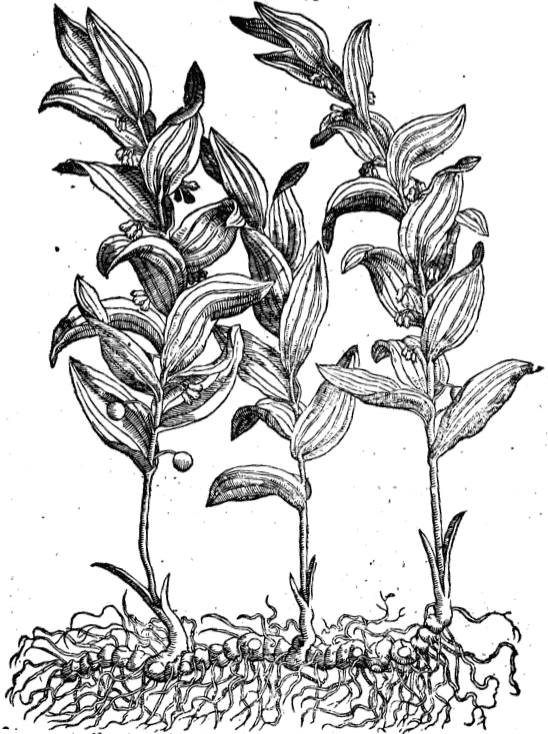 New Kreuterbuch, Matthiolus, 1563
New Kreuterbuch, Matthiolus, 1563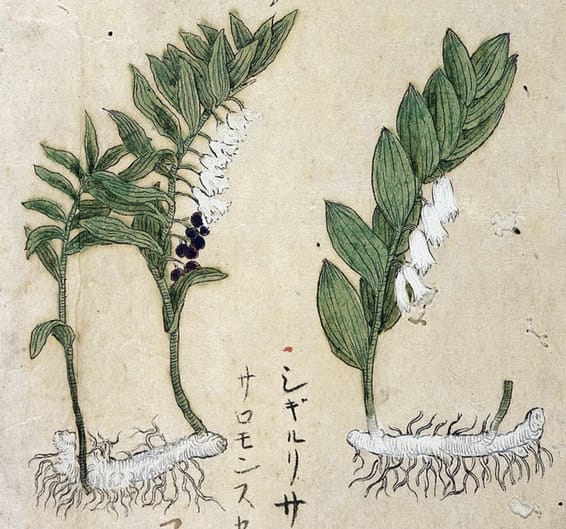 Japanese Herbal, 17th century (Welcome)
Japanese Herbal, 17th century (Welcome)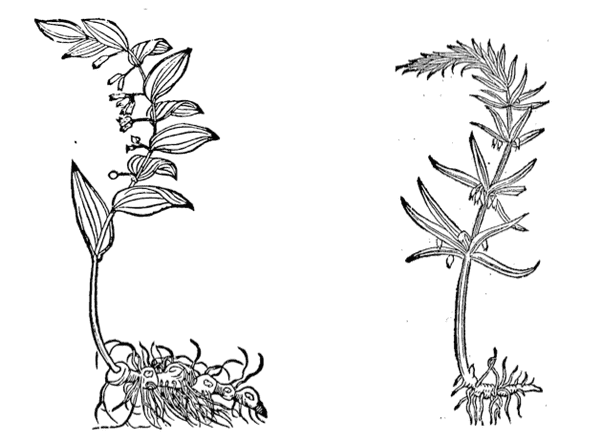 Official Soloman’s Seal Narrow-leaved Soloman’s Seal
Official Soloman’s Seal Narrow-leaved Soloman’s SealTurners Herbal, 1551 Dioscorides Materia Medica, Ruellio, 1549
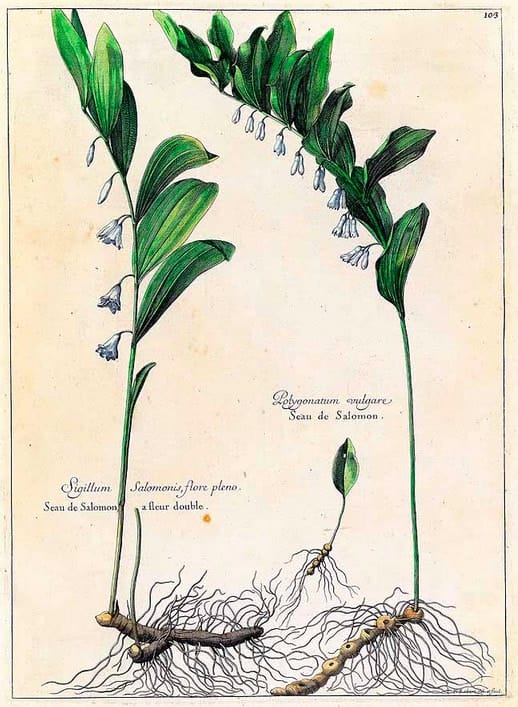 P. multiflorum
P. multiflorumDodart, Recueil des plantes gravées par ordre du roi Louis XIV, 1788
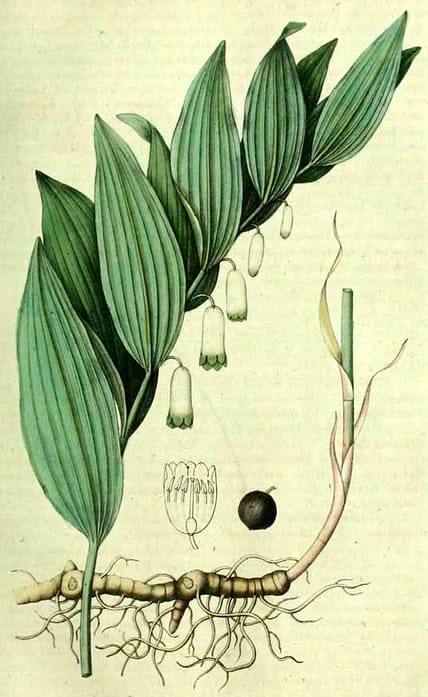
|
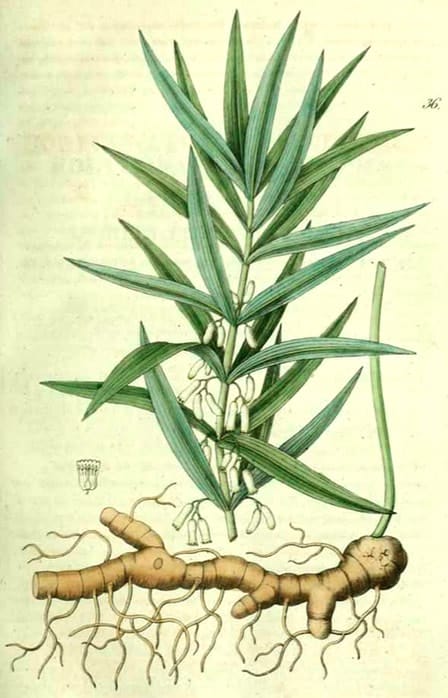
|
Dietrich, Flora regni borussici, 1832-1833
 SOLOMANS SEAL ROOT
SOLOMANS SEAL ROOTNotes on Pharmacognosy, Otto Augustus Wall, 1902
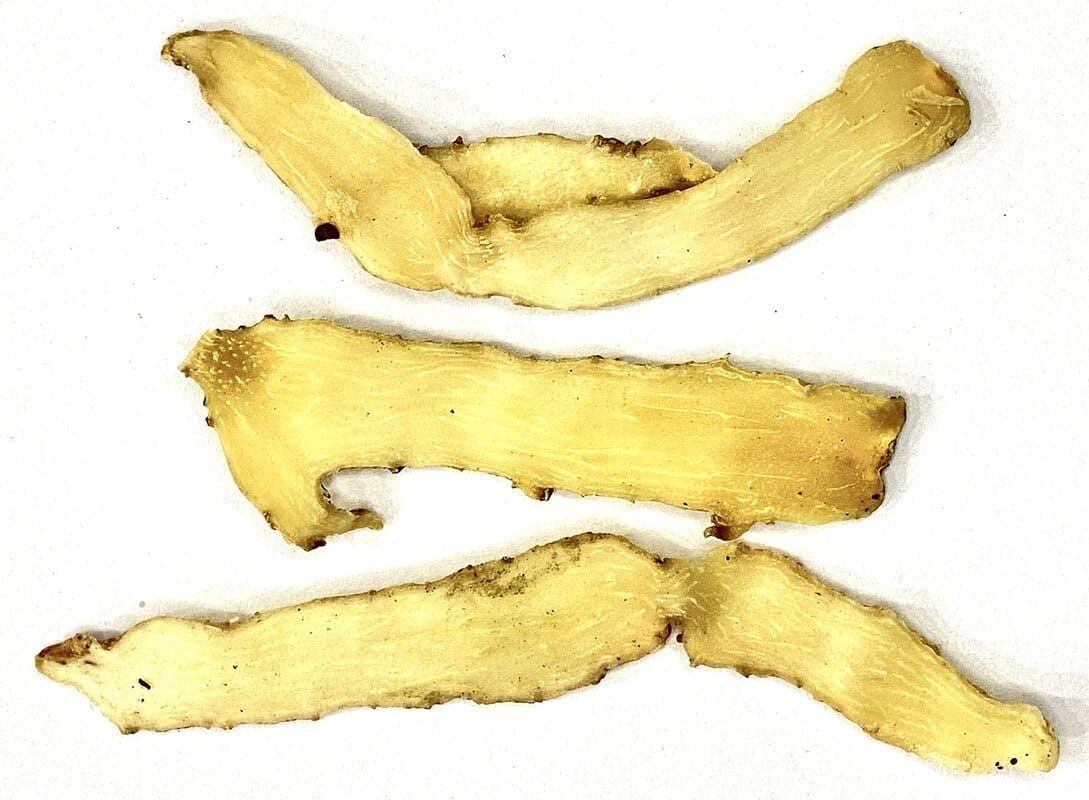 Slices of Polygonatum Yu Zhu
Slices of Polygonatum Yu Zhu(Adam, 2024)
Botanical name:
Polygonatum spp.
Broad and Narrow-leaved varieties were known in the West:
1. Broad-leaved (Regular or Official) Solomans Seal:
i. P. multiflorum
ii. P. odoratum
iii. P. officinale (syn. P. vulgare, P. unifolium) is said to be no longer (or less commonly) used.
2. Narrow-leaved Soloman’s Seal:
i. P. verticillatum and others (see below).
TCM uses 2 varieties of Polygonatum:
1. Yu Zhu (Broad-leaf variety):
i. P. odoratum (syn. P. latifolium, P. majus)
ii. P. inflatum
iii. P. pratti
iv. P. oppositifolium (used in Tibetan Medicine)
2. Huang Jing (Narrow-leaf variety, ‘Siberian Soloman’s Seal’):
i. P. sibiricum
ii. P. verticillatum
iii. P. kingianum
iv. P. cyrtonema
v. P. cirrhifolium (used in Tibetan Medicine)
The former is synonymous with P. officinale. The latter is a narrow-leaved variety and is synonymous with the narrow-leaved variety recognised in Europe.
P. biflorum is the American Soloman’s Seal with similar properties to the European variety.
Parts used:
Root
Temperature & Taste:
Temperate; ‘of a mixed temper’. Cool, moist. Sweet
Classifications:
2F. PURIFYING. 2G. CLEANSING. 2O. ASTRINGENTS. 2T. GLUTINATE
3M. ARTHRITICS
4k. ARTHRITIC
TCM:
B. Clears Deficient Heat
N. Yin Tonic
Uses:
OFFICIAL SOLOMAN’S SEAL (Yu Zhu):
1. Nourishes Yin, Generates Fluids:
-Lung Yin deficiency (dry) Cough, Bronchitis, Consumption (TCM, West)
-Stomach Yin deficiency with dry mouth, thirst
-late stages of Febrile diseases with dry mouth and thirst
-‘purification of the kidneys, loins, and urine, and for the removal of bladder stones’. (Langecker)
-Diabetes; Wasting
-‘all types of consumptive diseases’. (Li Shi Zhen)
-maintains a good complexion, promotes happiness and longevity. (Shen Nong Ben Cao)
2. Settles Wind, Moistens Sinews, Strengthens the Bones:
–rheumatism, arthritis, lower back pain and nephritis (TCM, West)
-Fractures, dislocations: important herb for healing fractures in the West
-pain and spasm of the Sinews (TCM)
-‘twitching of the tendons and muscles’. (Shen Nong Ben Cao)
3. Moves the Blood, Benefits the Heart:
-‘reliable means to separate coagulated blood’. (Haller, Medicin. Lexicon, 1755)
–Heart failure; Myocardial ischemia; Coronary Heart disease; Angina Pectoris
-Headache and restlessness (Zhen Quan)
4. Tonifies Qi:
-‘reinforces Qi’ (Xiao Bing); ‘replenishes Qi in the Five Viscera’ (Heart, Lungs, Liver, Spleen, Kidney) (Chen Cang Qi)
-‘makes the person feel happy and able to enjoy a long life’ (Chen Cang Qi)
-‘This drug can be used as a substitute for Ginseng root and Astragalus Huang Qi‘. (Li Shi Zhen)
-this function is usually applied to Huang Jing (below); however Yu Zhu has this effect also
5. Clears Heat, Resists Poison:
-‘Febrile diseases caused by Wind-Heat with fever’ (Li Shi Zhen)
–‘treats epidemic febrile diseases with mania’ (Da Ming)
-‘epidemic diseases with chills and fevers’ (Zhen Quan)
-side effects from Mineral medicines (Tao Hong Jing)
6. Externally:
-Gout, Arthritis, Rheumatism, Limb pain, chew the root and apply topically; or in poultices, plasters or ointments
-very beneficial applied to Dislocations and Fractures
-Distilled Water has been much used as a cosmetic (since the time of Galen)
-applied to Spots, Scars, Scabs, Marks and even Pock marks of the skin (West, TCM)
-externally for Freckles, Sun Burn, Morphew, Scabs and the rash of Measles and Small Pox.
-good application to Boils, Sores, Carbuncles, Furuncle as well as various forms of skin irritation.
-strong wash is used for Lice and Knits of the hair.
-Bruises, Hematoma, Ecchymoses
NARROW-LEAVED SOLOMAN’S SEAL (Huang Jing)
1. Tonifies the Spleen, Benefits Qi:
–debility after prolonged illness, and used as a restorative in chronic wasting disease.
-used for Deficiency of the Qi and Blood.
2. Nourishes Yin
-Lung Yin deficiency (dry) Cough, Bronchitis, Consumption (TCM, West, Tibet)
-Stomach Yin deficiency with dry mouth, thirst
-Diabetes; Wasting
-the wine-steamed root is warm, used for Impotence, Premature Ejaculation and Spermatorrhea
-“treats Five Overstrains and Seven Damages” (Da Ming)
-“replenishes the Vital Essence and Marrow” (Li Shi Zhen)
-“It can be served as life prolongation drug” (Li Shi Zhen)
-“Long-term taking of the drug makes one happy, not feel hun¬ gry and enjoy a long life”. (Ming Yi Bie Lu)
Dose:
Decoction: 6–15 grams;
Powder: 1–3 grams
Comment:
1. Despite their differing categories in TCM (one a Qi tonic, the other a Yin tonic), both varieties of Soloman’s Seal are similar in function and use. Yu Zhu is synonymous with the western Soloman’s Seal and may be used in its place. Both varieties were used similarly in the Western Tradition. Some classical Chinese sources (such as Chen Cang Qi) noted that the two types of Soloman’s Seal were ‘very similar’. Li Shi Zhen said “After studying both drugs, we find that they have similar functions”, but pointed out the Polygonatum Yu Zhu is stronger.
2. “It harmonizes the Five Viscera (Liver, Heart, Spleen, Lung and Kidney), makes the muscles strong, and consolidates the bones and marrow. The person will have much more strength, and look much younger, with lustrous Complexion. His white Hair will turn black, and Teeth which have fallen out will grow again”. (Li Shi Zhen)
3. Soloman’s Seal is similar to Comfrey, the two were often combined in the West. Both are classed as Yin tonics, thereby being Cool and moist. However, they both also demonstrate astringent effects, generally viewed as ‘drying’. They are very effective when combined for chronic diseases of the Bones and Joints, as well as for Fractures, Dislocation, Wounds and Hernia.
4. Tibetan Medicine uses narrow-leaved (P. cirrhifolium) and broad-leaved (P. oppositifolium) varieties of Soloman’s Seal. Both are used the same.
5. “It will purge the San Shi Chong (3 Haunting Spirits), the three haunting agents; The upper agent is called Pengzhi. It makes the person adore precious things. It requires taking of the drug for 100 days to purge it. The middle agent is called Pengjiao. It makes one addicted to fine flavors. It requires taking of the drug for 60 days to purge it. The lower agent is called Pengju. It makes the person infatuated with sex and the five colors. Thirty days are needed to drive it away. After taking the drug, all the three agents will be purged and defecated in the form of mucous substance.” (Li Shi Zhen)
Substitute:
1. Asparagus root has been used as a substitute
2. Russian sources sometimes use Malva verticillata seed
3. In some instances, Comfrey can be used
4. Soloman’s Seal; (Yu Zhu) can be used as a substitute for Ginseng and Astragalus Huang Qi (Li Shi Zhen)
Preparation:
1. Huang Jing is regarded as a Stomach and Spleen tonic, but at the same time it is heavy and cloying, and hard-to-digest. Therefore it is typically prepared with wine making it less heavy and difficult to digest, more warming and more tonifying.
2. Yu Zhu is also typically steamed with alcohol for use in TCM.
3. As soon as the root are dug they are washed then boiled in twice the amount of water until the water is absorbed. This makes the root more warming..(Tibet)
Main Combinations:
1. Consumption; Female weakness (Leukorrhea or excess Menstruation); Fractures, Dislocations and chronic joint disease, and for Hernia and Wounds, Soloman’s Seal with Comfrey root.
2. Hernia:
i. Soloman’s Seal with Comfrey root, Sanicle, Horsetail (as in Infusion for Hernia)
ii. Soloman’s Seal with Comfrey root and Aniseed (as in Powder for Hernia)
iii. Soloman’s Seal with Sage, Rupturewort, Agrimony, Plantain, Comfrey root, Burdock, Tormentil (as in Decoction for Hernia)
3. Kidney and Bladder Ulcers, Comfrey with Soloman’s Seal, Bistort, Ladies Mantle, Plantain (as in Potion for Ulcers of the Kidneys and Bladder)
4. Traum and Wounds, Soloman’s Seal with Sanicle, Golden Rod, Plantain, Sage (as in Vulnerary Decoction)
5. As a cosmetic:
i. infuse Soloman’s Seal in Bean water and wash the face to cleanse the skin and beautify (Herbarium Horstianum, 1630)
ii. distill a water from Soloman’s Seal, Lily of the Valley flower and White Lily root
TCM:
1. Stomach Yin deficiency with dry mouth and throat, Polygonatum Yu Zhu with Ophiopogon Mai Men Dong
2. Diabetes:
i. Polygonatum Huang Jiang with Lycium Gou Qi Zi
II. Polygonatum Huang Jiang with Rehmannia Shu Di Huang, Astragalus and Chinese Yam Shan Yao.
iii. Polygonatum Yu Zhu and Polygonatum Huang Jiang with Mulberry leaf (Sang Ye) (Huang Yu Sang Decoction which has a proven hypoglycemic effect)
3. Weakness, debility, Polygonatum Huang Jing with Ginseng.
TIBETAN:
1. Female weakness, Infertility, Soloman’s Seal with Asparagus root, Gymnadenia, Nutmeg, Clove, Aloeswood, Cardamon (as in Cardamon 7 (Sug smel 7) of Tibetan Medicine)
Major Formulas:
Infusion for Hernia
Decoction of Comfrey and Solomans Seal
Decoction for Hernia
Vulnerary Decoction
Powder for Hernia (Pharmacopoeia Extemporanea)
Cardamon 7 (Sug smel 7) (Tibetan)
Cardamon 19 (Sug smel bcu dgu) (Tibetan)
Catechu 25 (Seng ldeng 25) (Tibetan)
Withania 3 Decoction (Ba spru gsum thang) (Tibetan)
The Melting Solar Disk (Ju byed nyi mai dkyil khor) (Tibetan)
Cautions:
1. Not suitable for use in cases with excess Phlegm or Damp
2. Consumption of the berries has resulted in fatalities in children. (Gessner, The Poison and Medicinal Plants of Central Europe)
Main Preparations used:
Distilled Water
-
Extra Info
- Research
P. sibiricum / verticillatum
